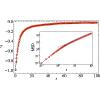当前位置:
X-MOL 学术
›
Phys. Rev. E
›
论文详情
Our official English website, www.x-mol.net, welcomes your feedback! (Note: you will need to create a separate account there.)
Run-and-tumble bacteria slowly approaching the diffusive regime.
Physical Review E ( IF 2.4 ) Pub Date : 2020-06-22 , DOI: 10.1103/physreve.101.062607 Andrea Villa-Torrealba 1 , Cristóbal Chávez-Raby 1 , Pablo de Castro 1 , Rodrigo Soto 1
Physical Review E ( IF 2.4 ) Pub Date : 2020-06-22 , DOI: 10.1103/physreve.101.062607 Andrea Villa-Torrealba 1 , Cristóbal Chávez-Raby 1 , Pablo de Castro 1 , Rodrigo Soto 1
Affiliation

|
The run-and-tumble (RT) dynamics followed by bacterial swimmers gives rise first to a ballistic motion due to their persistence and later, through consecutive tumbles, to a diffusive process. Here we investigate how long it takes for a dilute swimmer suspension to reach the diffusive regime as well as what is the amplitude of the deviations from the diffusive dynamics. A linear time dependence of the mean-squared displacement (MSD) is insufficient to characterize diffusion and thus we also focus on the excess kurtosis of the displacement distribution. Four swimming strategies are considered: (i) the conventional RT model with complete reorientation after tumbling; (ii) the case of partial reorientation, characterized by a distribution of tumbling angles; (iii) a run-and-reverse model with rotational diffusion; and (iv) a RT particle where the tumbling rate depends on the stochastic concentration of an internal protein. By analyzing the associated kinetic equations for the probability density function and simulating the models, we find that for models (ii), (iii), and (iv) the relaxation to diffusion can take much longer than the mean time between tumble events, evidencing the existence of large tails in the particle displacements. Moreover, the excess kurtosis can assume large positive values. In model (ii) it is possible for some distributions of tumbling angles that the MSD reaches a linear time dependence but, still, the dynamics remains non-Gaussian for long times. This is also the case in model (iii) for small rotational diffusivity. For all models, the long-time diffusion coefficients are also obtained. The theoretical approach, which relies on eigenvalue and angular Fourier expansions of the van Hove function, is in excellent agreement with the simulations.
中文翻译:

滚滚滚滚的细菌逐渐接近扩散状态。
细菌游泳者跟随奔跑(RT)的动力学过程,由于其持久性而首先产生弹道运动,然后通过连续的滚动产生扩散过程。在这里,我们研究了稀薄的游泳者悬架到达扩散状态需要多长时间,以及与扩散动力学的偏差幅度是多少。均方位移(MSD)的线性时间依赖性不足以表征扩散,因此,我们也关注位移分布的峰度。考虑了四种游泳策略:(i)翻滚后完全重新定向的常规RT模型;(ii)部分重新定向的情况,其特征在于翻转角的分布;(iii)具有旋转扩散的运行和反向模型;(iv)RT粒子,其中翻滚速率取决于内部蛋白质的随机浓度。通过分析概率密度函数的相关动力学方程并模拟模型,我们发现,对于模型(ii),(iii)和(iv),扩散的弛豫所需的时间要比滚落事件之间的平均时间长得多,证明粒子位移中存在大尾巴。此外,过量峰度可呈现较大的正值。在模型(ii)中,对于某些翻转角度分布,MSD可能达到线性时间依赖性,但是,动力学仍然长时间保持非高斯状态。模型(iii)中的旋转扩散率也较小。对于所有模型,还可以获得长期扩散系数。理论方法
更新日期:2020-06-22
中文翻译:

滚滚滚滚的细菌逐渐接近扩散状态。
细菌游泳者跟随奔跑(RT)的动力学过程,由于其持久性而首先产生弹道运动,然后通过连续的滚动产生扩散过程。在这里,我们研究了稀薄的游泳者悬架到达扩散状态需要多长时间,以及与扩散动力学的偏差幅度是多少。均方位移(MSD)的线性时间依赖性不足以表征扩散,因此,我们也关注位移分布的峰度。考虑了四种游泳策略:(i)翻滚后完全重新定向的常规RT模型;(ii)部分重新定向的情况,其特征在于翻转角的分布;(iii)具有旋转扩散的运行和反向模型;(iv)RT粒子,其中翻滚速率取决于内部蛋白质的随机浓度。通过分析概率密度函数的相关动力学方程并模拟模型,我们发现,对于模型(ii),(iii)和(iv),扩散的弛豫所需的时间要比滚落事件之间的平均时间长得多,证明粒子位移中存在大尾巴。此外,过量峰度可呈现较大的正值。在模型(ii)中,对于某些翻转角度分布,MSD可能达到线性时间依赖性,但是,动力学仍然长时间保持非高斯状态。模型(iii)中的旋转扩散率也较小。对于所有模型,还可以获得长期扩散系数。理论方法



























 京公网安备 11010802027423号
京公网安备 11010802027423号